Spine Surgery Robots Market Size and Trends
The spine surgery robots market is estimated to be valued at USD 253.8 Mn in 2025 and is expected to reach USD 612.5 Mn by 2032, growing at a compound annual growth rate (CAGR) of 13.4% from 2025 to 2032.
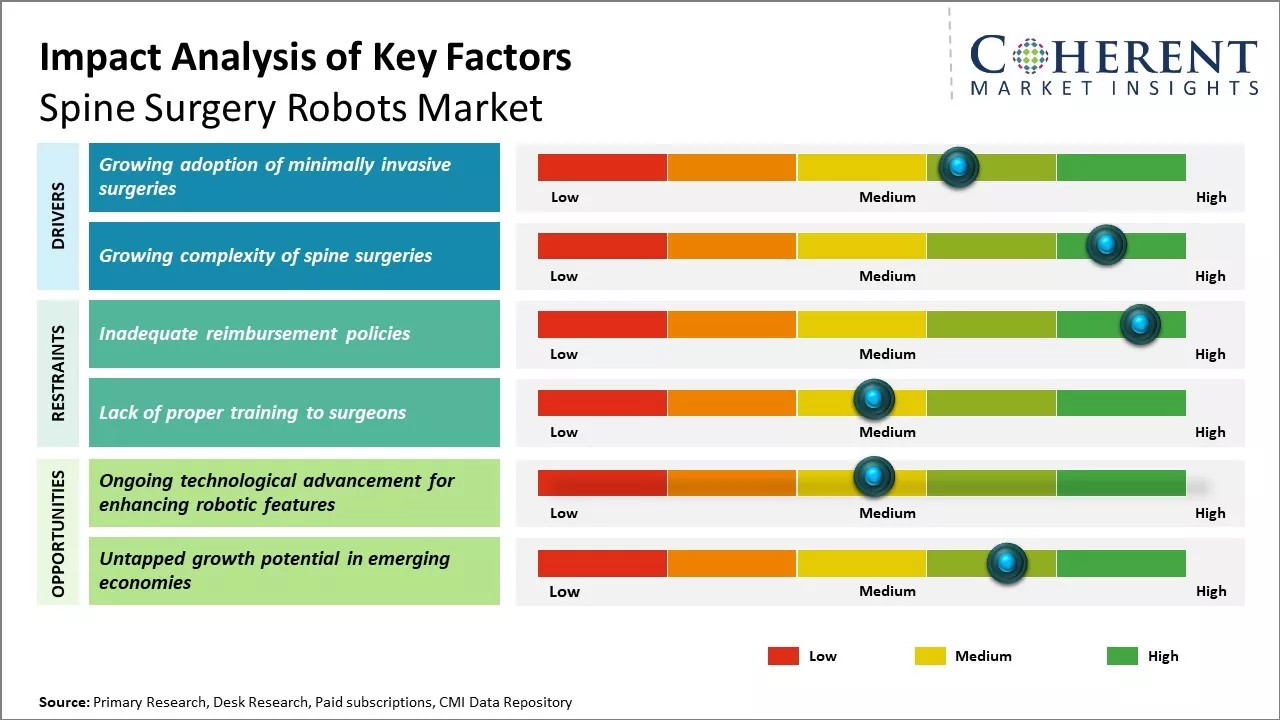
Discover market dynamics shaping the industry: Download Free Sample
The market is expected to witness significant growth during the forecast period. This is attributed to an increase in the adoption of spine surgery robots and rising number of spine surgeries being carried out annually across the globe. Technological advancements leading to the introduction of innovative systems and rise in funding for robotic technologies research is also expected to support the market growth. Growing geriatric population suffering from orthopedic disorders and rising awareness about the benefits offered by robotic systems over conventional spinal surgeries are some other factors anticipated to drive the global spine surgery robots market in the coming years.
Growing adoption of minimally invasive surgeries
The primary driver for the growth of spine surgery robots is the increasing adoption of minimally invasive surgical procedures across the globe. Minimally invasive surgeries offer various benefits over traditional open surgeries such as smaller incisions, lesser trauma to tissues, reduced blood loss, shorter hospital stays, and quicker recovery times. This has led to growing demand among both surgeons and patients for minimally invasive options. Spine surgeries performed using robots allow for very small incisions compared to open or even conventional minimally invasive surgeries through the usage of multiple robotic arms controlled by the surgeon console. Robotic systems provide surgeons with enhanced visualization and more precise control and flexibility of instruments in tight operative corridors. The intricate anatomy of the spine, especially in complex revision cases, is easily navigated with the assistance of robotics. Hospitals and ambulatory surgery centers are also propelled to invest in spine surgery robots as their usage has been demonstrated to reduce post-operative pain and lead to faster return to normal activities for patients. With an aging global population experiencing more degenerative spine conditions, and issues such as obesity further exacerbating spine problems, the shift towards minimally invasive treatments will continue growing in the future.
Market Concentration and Competitive Landscape
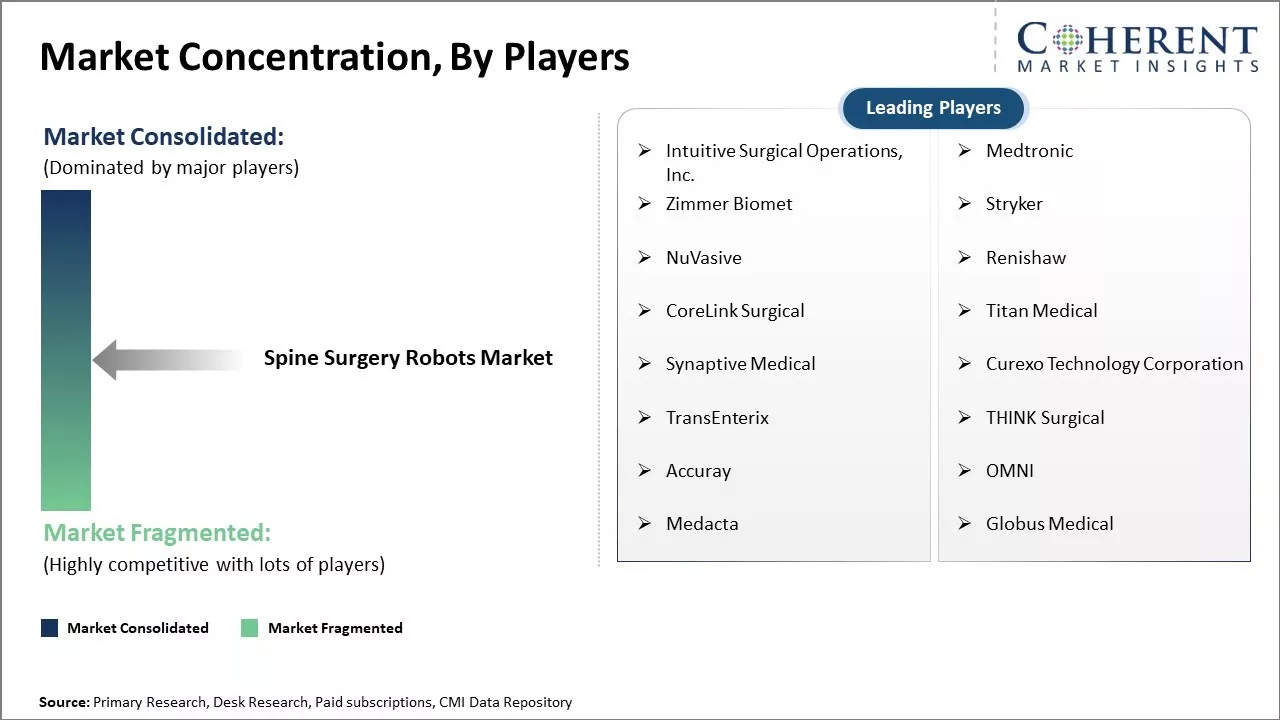
Get actionable strategies to beat competition: Download Free Sample
Growing complexity of spine surgeriesAnother key factor augmenting the market potential for spine surgery robots is the rising complexity of procedures being performed. Modern spinal treatments now involve very intricate surgeries for conditions such as scoliosis, segmental spinal instrumentation, and tumor excisions which place high technical demands on surgeons. Complexity is further increased in revision cases where surgeons have to work around previous hardware and scar tissue. While experienced surgeons are capable of handling many complex procedures through conventional or minimally invasive means, robots allow for improved ergonomics over lengthy operations. Surgeons can remain seated comfortably at the console instead of standing bent over the patient for several hours. Tremors and small hand movements which are difficult to avoid for long periods get filtered out by robotics resulting in possibly more precise placements of screws, rods or other implants. This facilitates handling intricate anatomy and redoing some steps more accurately. The robot's imaging, instrumentation. and scaling of motions enhance precision which assumes great value in revisions, tumors and other advanced spine cases. Experience shows robots may assist in expanding treatment options for complex conditions in the future.
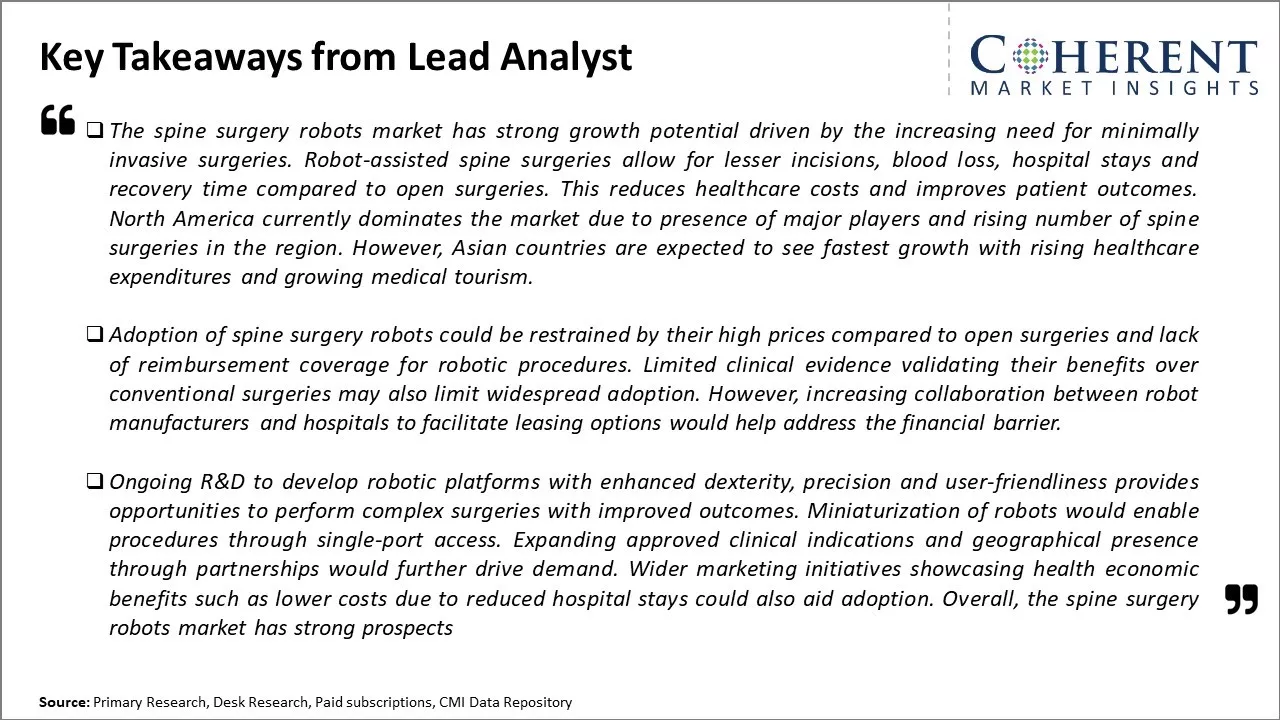
To learn more about this report, Download Free Sample
Market Challenges: Inadequate reimbursement policiesThe spine surgery robots market faces several challenges. High upfront equipment and maintenance costs have made hospitals hesitant to invest in robotic surgery. Many surgeons also need extensive training to operate robots proficiently, requiring an additional financial commitment. Some procedures also remain difficult to automate, like soft tissue manipulations. Reimbursement policies sometimes do not adequately cover the additional costs of robotic surgery either. Convincing patients of the benefits compared to traditional spine surgeries also takes marketing efforts.
Market Opportunities: Ongoing technological advancement for enhancing robotic features
A growing geriatric population undergoing more spine surgeries creates increased demand. Robotic systems offer improved precision, flexibility, and vision over manual ones. This can potentially reduce complications and lead times for patients. Ongoing technological advancements are enhancing robotic dexterity and autonomous functions. Favorable clinical evidence demonstrating superior outcomes versus open surgeries would help accelerate the market development over the forecasted period.
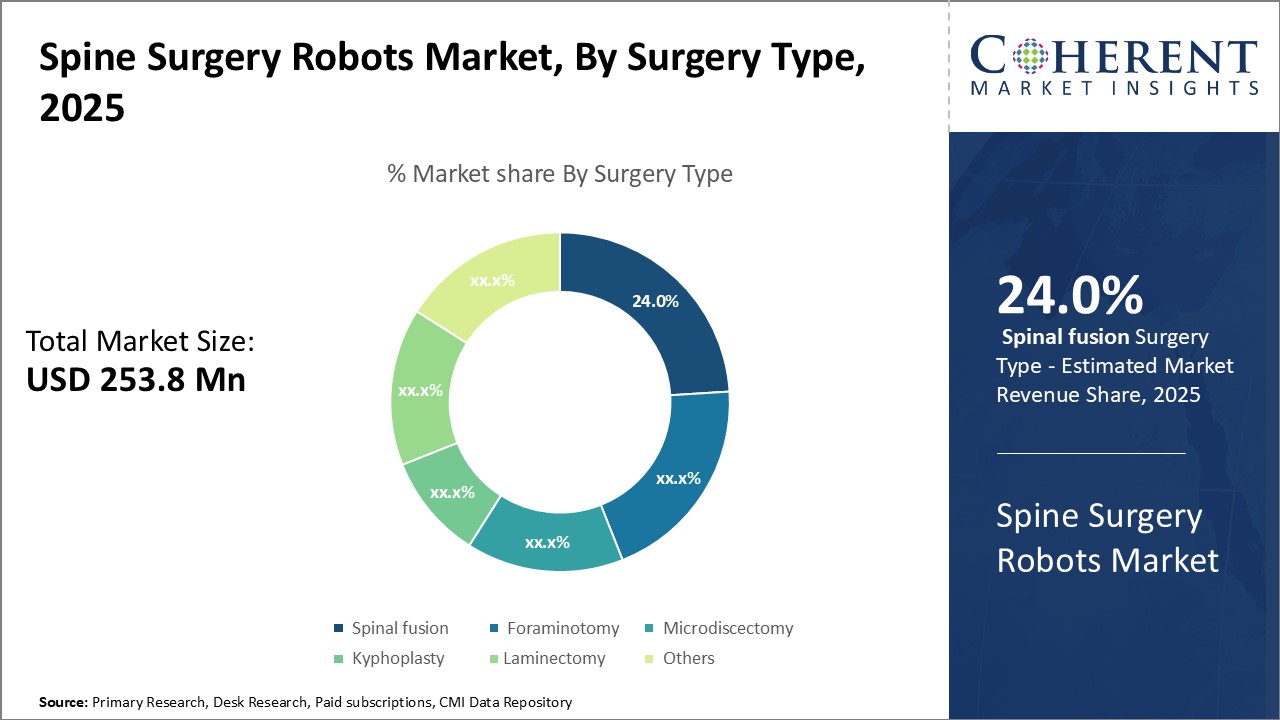
Discover high revenue pocket segments and roadmap to it: Download Free Sample
Insights, By Surgery Type: Rise in the cases of spinal disorientationThe surgery type segment includes laminectomy, foraminotomy, microdiscectomy, kyphoplasty, spinal fusion, and others. Spinal fusion segment is anticipated to hold 24.0% of the market share in 2025. Spinal fusion surgeries are highly complex procedures that involve fusing two or more vertebrae in the spine to eliminate motion and correct spinal alignment. Such precision surgeries require the use of robotic arms, navigation systems, 3D imaging capabilities, and other advanced technologies to aid surgeons in accurately placing spinal implants and ensuring proper fusion between vertebrae. Spine surgery robots provide enhanced dexterity, three-dimensional views and other benefits compared to manual techniques that help optimize outcomes in spinal fusion surgeries. With continuous technological upgrades focusing on improving safety, accuracy, and efficiency, spine surgery robots are witnessing higher adoption among surgeons for treating a variety of spinal fusion cases involving scoliosis, spinal stenosis and degenerative disc disease.
Insights, By Indication: Increasing prevalence of degenerative disc cases
The indication segment includes herniated discs, scoliosis, spinal stenosis, spondylolisthesis, degenerative disc disease, and others. Degenerative disc disease contributed the highest share of the spine surgery robots market and is projected to hold 27.6% of the market share in 2024. Degenerative disc disease refers to wear and tear changes occurring in the shock-absorbing discs between vertebrae. It commonly develops as a natural consequence of aging where the water content of discs starts declining, making them thin and weak. Additional factors such as excessive weight, smoking, lack of exercise, and strenuous jobs can accelerate degenerative changes. With growing elderly population worldwide and rising lifestyle-linked health issues, cases of back problems due to weakened discs are on the rise. Spine surgery robots help optimize outcomes for patients through improved accuracy, precision, and visualization during complex disc replacement and fusion surgeries.
Insights, By End User: Growing preference for minimally invasive surgeries drives the hospital segment growth
The end user segment includes hospitals, specialty clinics, ambulatory surgical centers, and others. Hospitals contributed the highest share of the spine surgery robots market and is projected to hold 39.8% of the market share in 2025. Spine surgeries within hospitals can leverage dedicated operation theaters equipped with latest-generation robotic systems. The robotic technology enables minimally-invasive procedures within small entry points that result in reduced hospitalization times for patients. For hospitals, spine surgery robots minimize chances of surgical mistakes and related liability risks. They also help optimize facility resources through the ability to perform multiple types of spinal procedures with the same capital equipment. This streamlines operations and maximizes return on investment for robotic programs undertaken by hospitals. Advanced technologies facilitate complex surgeries at lower costs with superior outcomes for challenging spinal cases.
Regional Insights
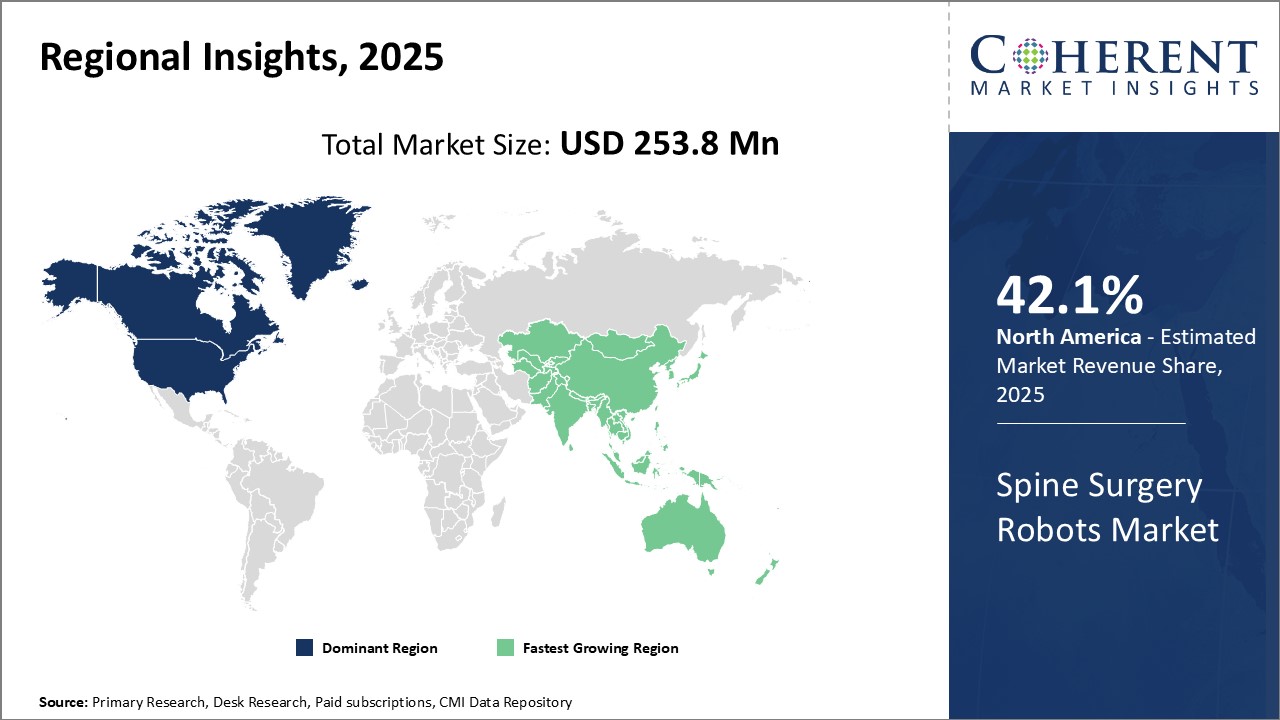
Need a Different Region or Segment? Download Free Sample
North America has dominated the spine surgery robots market for several years owing to a strong presence of key industry players and advanced healthcare infrastructure in the region and is expected to hold 42.1% of the market share in 2025. Hospitals in the U.S. are focusing on minimally invasive surgeries to reduce complications and healthcare costs, driving the demand for robot-assisted solutions. Moreover, favorable reimbursement policies have supported higher procurement and maintenance of expensive robotic systems. Major players like Mazor Robotics, Medtronic, and Zimmer Biomet have established their headquarters in the U.S. and are continuously investing in R&D to develop innovative solutions. Availability of skilled professionals to operate these complex systems has further encouraged their adoption across large medical facilities. However, lack of clinical data demonstrating long-term benefits over traditional open surgeries could slow down growth in late forecast period.
Asia Pacific is recognized as the fastest growing regional market. Countries like China, India, and Japan are witnessing significant increase in the geriatric population vulnerable to spinal disorders. Growing medical tourism is also attracting patients from other regions to Asia Paific for minimally invasive surgeries. This has prompted hospitals to invest in robotic technologies to enhance their surgical capabilities and gain competitive edge. At the same time, local manufacturers are collaborating with global pioneers to launch affordable indigenous systems. While technology adoption is relatively lower than western countries, increasing healthcare spending coupled with initiatives by governments to promote medical device sectors will boost the market growth over the next decade.
Market Report Scope
Spine Surgery Robots Market Report Coverage
| Report Coverage | Details | ||
|---|---|---|---|
| Base Year: | 2024 | Market Size in 2025: | USD 253.8 Mn |
| Historical Data for: | 2020 To 2024 | Forecast Period: | 2025 To 2032 |
| Forecast Period 2025 to 2032 CAGR: | 13.4% | 2032 Value Projection: | USD 612.5 Mn |
| Geographies covered: |
|
||
| Segments covered: |
|
||
| Companies covered: |
Intuitive Surgical Operations, Inc., Medtronic, Zimmer Biomet, Stryker, NuVasive, Renishaw, CoreLink Surgical, Titan Medical, Synaptive Medical, Curexo Technology Corporation, TransEnterix, THINK Surgical, Accuray, OMNI, Medacta, Globus Medical, Homedics, and Glanbia PLC |
||
| Growth Drivers: |
|
||
| Restraints & Challenges: |
|
||
Uncover macros and micros vetted on 75+ parameters: Get instant access to report
Market Segmentation
- Surgery Type Insights (Revenue, USD MN, 2020 - 2032)
- Laminectomy
- Foraminotomy
- Microdiscectomy
- Kyphoplasty
- Spinal fusion
- Others
- Indication Insights (Revenue, USD MN, 2020 - 2032)
- Herniated Discs
- Scoliosis
- Spinal Stenosis
- Spondylolisthesis
- Degenerative Disc Disease
- Others
- End User Insights (Revenue, USD MN, 2020 - 2032)
- Hospitals
- Specialty Clinics
- Ambulatory Surgical Centers
- Others
- Regional Insights (Revenue, USD MN, 2020 - 2032)
- North America
- U.S.
- Canada
- Latin America
- Brazil
- Argentina
- Mexico
- Rest of Latin America
- Europe
- Germany
- U.K.
- Spain
- France
- Italy
- Russia
- Rest of Europe
- Asia Pacific
- China
- India
- Japan
- Australia
- South Korea
- ASEAN
- Rest of Asia Pacific
- Middle East
- GCC Countries
- Israel
- Rest of Middle East
- Africa
- South Africa
- North Africa
- Central Africa
- North America
- Key Players Insights
- Intuitive Surgical Operations, Inc.
- Medtronic
- Zimmer Biomet
- Stryker
- NuVasive
- Renishaw
- CoreLink Surgical
- Titan Medical
- Synaptive Medical
- Curexo Technology Corporation
- TransEnterix
- THINK Surgical
- Accuray
- OMNI
- Medacta
- Globus Medical
- Homedics
- Glanbia PLC
Share
Share
About Author
Manisha Vibhute is a consultant with over 5 years of experience in market research and consulting. With a strong understanding of market dynamics, Manisha assists clients in developing effective market access strategies. She helps medical device companies navigate pricing, reimbursement, and regulatory pathways to ensure successful product launches.
Missing comfort of reading report in your local language? Find your preferred language :
Transform your Strategy with Exclusive Trending Reports :
Frequently Asked Questions
EXISTING CLIENTELE
Joining thousands of companies around the world committed to making the Excellent Business Solutions.
View All Our Clients
